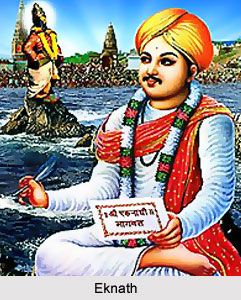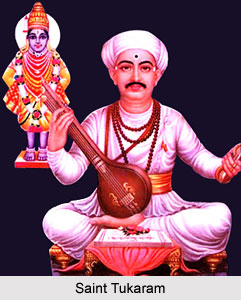 Renaissance in Modern Marathi Literature gets reflected through the different literary works including prose, fiction, poetry and drama. Marathi language is referred to as one of the Prakrit language. The first Marathi poet, Mukunderaj, lived between 1128 and 1298 A.D. Early Marathi literature is considered as mostly devotional and four great saint-poets are remembered as the stalwarts - Sant Jnaneshwar (1271-1296), Eknath (1533-1599), Tukaram (1608-1649) and Ramdas (1608-1681). The medieval Marathi literature is full of Pandit-poets like Vamanpandit and Moropant.
Renaissance in Modern Marathi Literature gets reflected through the different literary works including prose, fiction, poetry and drama. Marathi language is referred to as one of the Prakrit language. The first Marathi poet, Mukunderaj, lived between 1128 and 1298 A.D. Early Marathi literature is considered as mostly devotional and four great saint-poets are remembered as the stalwarts - Sant Jnaneshwar (1271-1296), Eknath (1533-1599), Tukaram (1608-1649) and Ramdas (1608-1681). The medieval Marathi literature is full of Pandit-poets like Vamanpandit and Moropant.
The modern period in Marathi literature started with the missionaries, who established printing presses and brought prose in printed form into trend. In the year 1808, the first Marathi printed work appeared and further in the year 1834 the first Marathi newspaper, Darpana, was published. First Marathi Literary Institution was established in 1848. Most of the nineteenth century prose and poetry of Marathi literature is polemical and instructive. The first Marathi novel written by Baba Padmanji was published in 1857. The so called `New Age` in Marathi literature started with the nationalistic poet, Keshava Suta (1866-1905) and novelist Hari Narayana Apte (1864-1919). They were the .pioneers of a literary renaissance in Marathi literature.
Poetry in Marathi Literature
The romantic upsurge in poetry was expressed in the nature-poetry of preacher N.V. Tilak (1865-1919) and the love-poems and passionate plays of R.G. Gadkari (1885-1919); in the simple and impulsive lyricism of Balkavi (1890-1918) and the philosophic compositions of Bee (1872-1947) and Tambe (1874-1941) borrowed some symbols and images from Tagore. The `Ravikiran Mandal`, a group of seven poets, dominated a part of modern Marathi literature and they stated that poetry was not for the well-educated instead it was a part of everyday life. A reaction came in the form of progressive poets like Anant Kanekar, who in his only collection of poetry in 1933 underlined class-struggle. He was one of the most articulate advocates of cultural freedom. Later poets like Vinda Karandikar and Sharach-Chandra Muktibodh followed the trail and wrote poetry which revolutionised the themes. Poetry of Kusumagraj and Vasant Bapat reflect socialist causes.
Drama in Marathi Literature
 While poetry is becoming more and more unintelligible, drama continues to thrive and maintain its rich tradition. Marathi stage was born in 1843 and has an illustrious line of great dramatists. Vaatak translated Bjornson`s `The Gauntlet` in 1933 and with Rangnekar and P. K. Atre, a new school of drama used as a form of social satire started. Both playwrights of immense popularity, Atre and Rangnekar, however, did not raise the literary standard of Marathi drama. Further, there has been a new realisation of writing psycho-analytical plays meant for the new stage. P. L Deshpande, Vijay Tendulkar and Vasant Keretkar experimented in reviving the stage with the very significant contribution of creating new round characters instead of mere flat monochrome `types`, in handling situations of social helplessness and frustration with an underlying streak of comedy and satire, and in reviving historical plays without their old insistence on sabre-rattling and clap-trap trick scenes and thundering speeches. Maharashtra has some very great stage talent. Meanwhile, there has been a very meaningful upsurge of the folk-drama forms such as Tamasha and plays in dialects. The folk medium is largely used for various purposes like political propaganda, social reform and even sheer entertainment. But the rural stage has its limitations. Very little has been done to combine the folk-drama form and idiom with a modernised content. However, some writers are trying to fill the gap between the city and the village in short-stories and fiction, drama is still wavering between the two pulls of sophisticated depth, psychology and broadsides with bawdy humour pleasing the common illiterate playgoer.
While poetry is becoming more and more unintelligible, drama continues to thrive and maintain its rich tradition. Marathi stage was born in 1843 and has an illustrious line of great dramatists. Vaatak translated Bjornson`s `The Gauntlet` in 1933 and with Rangnekar and P. K. Atre, a new school of drama used as a form of social satire started. Both playwrights of immense popularity, Atre and Rangnekar, however, did not raise the literary standard of Marathi drama. Further, there has been a new realisation of writing psycho-analytical plays meant for the new stage. P. L Deshpande, Vijay Tendulkar and Vasant Keretkar experimented in reviving the stage with the very significant contribution of creating new round characters instead of mere flat monochrome `types`, in handling situations of social helplessness and frustration with an underlying streak of comedy and satire, and in reviving historical plays without their old insistence on sabre-rattling and clap-trap trick scenes and thundering speeches. Maharashtra has some very great stage talent. Meanwhile, there has been a very meaningful upsurge of the folk-drama forms such as Tamasha and plays in dialects. The folk medium is largely used for various purposes like political propaganda, social reform and even sheer entertainment. But the rural stage has its limitations. Very little has been done to combine the folk-drama form and idiom with a modernised content. However, some writers are trying to fill the gap between the city and the village in short-stories and fiction, drama is still wavering between the two pulls of sophisticated depth, psychology and broadsides with bawdy humour pleasing the common illiterate playgoer.
Fiction in Marathi Literature
Marathi novel and short stories have passed through all those stages of historical romance and social reform tracts to mere `art for art`s sake` entertainers. Lots of translations of western literature have been made. Then followed another significant group of four, who stand out for being different and renowned for short-stories are S. N. Pendse, Vyankatesha Madgulkar, Aravind Gokhale and P. B. Bhave. Bhave is a painter of prehistoric passions and wields a powerful pen. There are other younger short-story writers and one can find an oblique reference to modern events or happenings in the novels of contemporary writers. Biwalkar wrote a novel on Gandhi`s work; G.N. Dandekar wrote a novel on Bhakra-Nangal (Amhi Bhagirathache Putra), Phadke wrote a trilogy of novels on Subhas Bose and the Indian National Army. Contemporary younger novelists and short-story writers are more focussed on giving fine, objective, non-sentimental snap-shots of some regional culture or agony. The interest of the fiction-writer seems to be the futility of the human condition and a thin coating of humour does exist in their write-ups.
Belles-Lettres in Marathi Literature
Of late, travelogue has become one of the most popular literary forms for the Indian writers. In Marathi language too, excellent travelogues are written by Gangadhar Gadgil, Prabhakar Padhye, Anant Kanekar, R.B. Joshi, P.L. Deshpande and others. Late Kusumavati Deshpande wrote excellent personal essays and sketches. But now a new form which is a pleasant mixture of the prose-poem, reflective essay, reminiscence and epistolary writing has developed.
Marathi literature is noted for its intellectual pursuits. Lexicography and bibliographical work in Marathi language has several great names. Marathi has many works on useful arts and sciences, agriculture, architecture, law and medicine.













